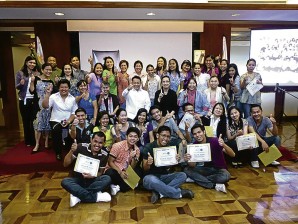
BSP Deputy Governor Diwa Guinigundo (center, in barong) celebrates with participants the successful completion of the IIE series. EUGENE ARANETA
Just the view would have been treat enough.
To see Manila Bay several meters from the ground, unobstructed by jetsam and flotsam and structures that now make what was once one of—if not the—world’s most wondrous sunsets simply a picture on a postcard, was one of the things that enthralled the teachers on their first visit to Bangko Sentral ng Pilipinas (BSP).
The country’s top monetary authority, BSP, hosted the briefing and debriefing of the teachers who signed up for the IIE’s financial literacy series, “You Can Bank on It,” which was cosponsored by Citibank Philippines.
Among the teachers were (in alphabetical order) Eva Almaras, Irene Aquino, Erasto Arinuelo, Janus Myrrh Baldomero, Dennis Balonzo, Anelyn Barles, Manolo Barles, Morena Biscocho, Josefina Bustos, Ronald Cabus, Raquel Castro, Gina Cristobal, Carolina Eligio, Jackie Louie Engay, Charlton Eugenio, Thelma Fabellon, Fritz Ferran, Norman Fortun, Marilou Gruspe, Nora Isorena, Rechilda Ligson, Mariel Eugene Lopez, Maria Theresa Ruiz, Rubie Santa Ana, Jaime Sarabosing, Salvador Sergote, Marife Sonza, Michelle Testa, Maria Fe Tragura, Melvin Ubaldo, Linda Varca, Elenita Venson, Kheryl Casey Vibal, Jovy Victorino and Recilinda Zubiri.
The sessions gave the teachers a chance to discover what lay behind the imposing and formal facade of the BSP complex. They found out the BSP was not only the repository of the nation’s wealth but also a treasure trove of attractions that would delight everyone.
The BSP, headed by Fe de la Cruz, director for corporate affairs, arranged a tour of the complex so the teachers could discover the many interesting educational opportunities for their students, if they would only consider field trip destinations other than noontime shows and malls.
Wouldn’t young, inquisitive minds be delighted to know the history of money and the evolution of the Philippine currency at the Money Museum?
Small groups could even have their pictures printed on copies of the new peso bearing whatever currency they want, up to P100,000.
The teachers also viewed intricately designed jewelry in gold at its purest that formed part of the Metropolitan Museum’s gold collection. (It is said even European jewelers, who design for royalty, find early Filipino jewelers comparable with the best.)
During the debriefing, the Met had a Japanese animé and manga exhibit that would have drawn the participants if they were not committed to attend the closing session.
Also open by then was the Money Matters for Kids traveling exhibit that cosponsor Citibank had donated to BSP.
The trip to the BSP audiovisual room, where both briefing and debriefing were held, took the participants on a route lined with the best works of Filipino artists and artisans—paintings by the masters and traditional wooden furniture, even antiques, by skilled craftsmen.
But, of course, after both the opening and closing sessions, it was the uninterrupted view of Manila Bay, usually enjoyed only by the Philippines’ top financial managers and monetary officials, that had the teachers enthralled.
If everybody could sit at only one side of the dining tables—the one facing the bay—as they enjoyed the lunches and merienda so graciously provided by the host, no doubt they would have.
The icing on their cake was the speech at the end of the debriefing by Deputy Governor Diwa Guinigundo, who told them how important the BSP considered financial education in advancing national progress because financially literate citizens made wise decisions that helped achieve development goals.